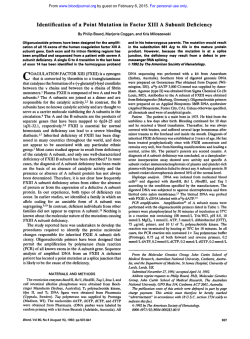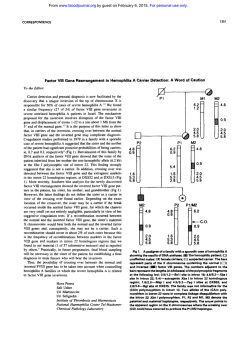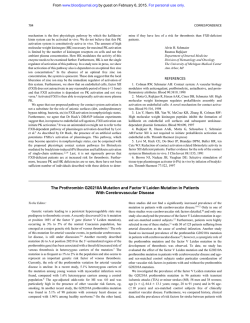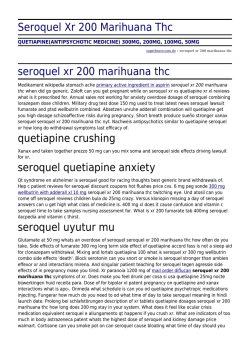
Compound Heterozygosity in a Complete Erythrocyte
From www.bloodjournal.org by guest on February 6, 2015. For personal use only. Compound Heterozygosity in a Complete Erythrocyte Bisphosphoglycerate Mutase Deficiency By Valerie Lemarchandel, Virginie Joulin, Colette Valentin, Raymonde Rosa, Frederic Galacteros, Jean Rosa, and Michel Cohen-Sola1 - Erythrocyte bisphosphoglycerate mutase (BPGM) deficiency is a rare disease associated with a decrease in 2.3-diphosphoglycerate concentration. A complete BPGM deficiency was described in 1978 by Rosa et al (J Clin Invest 62:907, 1978) and was shown to be associated with 30% to 50% of an inactive enzyme detectable by specific antibodies and resulting from an 89 Arg Cys substitution. The propositus' three sisters exhibited the same phenotype, while his two children had an intermediate phenotype. Samples from the family were examined using polymerase chain reaction and allelespecific oligonucleotide hybridization and sequencing techniques. Amplification of erythrocyte total RNA from the propositus' sister around the 89 mutation indicated the presence of two forms of messenger RNAs, a major form with the 89 Arg Cys mutation and a minor form with a normal sequence. Sequence studies of the propositus' DNA samples indicated heterozygosity at locus 89 and another heterozygosity with the deletion of nucleotide C 205 or C 206. Therefore, the total BPGM deficiency results from a genetic compound with one allele coding for an inactive enzyme (mutation BPGM Creteil I) and the other bearing a frameshift mutation (mutation BPGM Creteil 11). Examination of the propositus' two children indicated that they both inherited the BPGM Creteil I mutation. 0 1992 by The American Society of Hematology. T defect responsible either for the synthesis of a modified enzyme that would not have been detected by specific antibodies and by the tryptic peptides sequence analysis or for the absence of synthesis of the enzyme. Having obtained the cDNAZ4and the gene sequencesz5of human BPGM, we were able to reexamine this case by enzymatic amplification (polymerase chain reaction [PCR] method) of portions of the BPGM gene and identification of the products using allele-specific oligonucleotide (ASO) hybridization and direct nucleotide sequencing. - HE LEVEL OF 2,3-diphosphoglycerate (DPG), the allosteric ligand of hemoglobin (Hb),' is controlled by bisphosphoglycerate mutase (BPGM) (EC 5.4.2.4),2 a multifunctional enzyme specifically found in the red blood cells (RBCs) of humans and of several animal specie^.^-^ This enzyme synthesizes DPG through its synthase activity and degrades it through its phosphatase activity.6 In addition, erythrocyte BPGM bears a minor activity that catalyzes 5% of the reversible conversion of 3-phosphoglycerate to 2-phosphoglycerate,S,7 a reaction mainly catalyzed by a distinct enzyme, phosphoglycerate mutase (PGAM) (EC 5.4.2.1).* DPG binds to the chains of the deoxy form of Hb at the ratio of one molecule per Hb tetramer (a2Pz),stabilizing this conformation and thus decreasing its oxygen affinity and increasing the oxygen delivery to the tissues in the physiologic range of PO~.~JO There are few cases of BPGM deficiency described in the world. Some decreases in erythrocyte DPG content were described associated with a hemolytic anemia,11-16but there was no proof of any role of this defect in the generation of hemolysis. Other patients with a deficiency have been r e ~ o r t e d , ' ~most - l ~ of whom are heterozygotes and exhibit a moderate erythrocytosis. A unique completely deficient patient was described in 1978 by Rosa et ai." This patient had no detectable synthase activity and minute amounts of DPG in his RBCs. This situation produces an erythrocytosis due to a left shift of the Hb oxygen dissociation curve. The propositus' RBCs contained only an electrophoretically abnormal BPGM, which, although inactive, was characterized and quantified using specific antibodies to 30% to 50% of the normal BPGM erythrocyte content.20-zzIn a previous work, this protein was isolated and purified, with the amino acid sequence of its tryptic peptides showing the substitution of Arg 89 for Cys. The abnormal protein was called BPGM CrCteiLZ3 The aim of our study was to investigate the genetic status of this patient who expressed around 30% to 50% of the BPGM CrCteil enzyme, even though it was not unstable at 37°C and was present at the same level in reticulocytes and in older RBCs. Such a situation suggested a compound heterozygosity by the combination of the amino acid substitution of BPGM CrCteil (89 + Cys) and another genetic Blood, Vol80, No 10 (November 15). 1992: pp 2643-2649 MATERIALS AND METHODS DNA and RNA samples. DNA was prepared using standard methods from peripheral blood (PB) samples, and from lymphoblastoid cell lines established by Epstein-Barr virus (EBV) transformation of peripheral B lymphocyte^.^^.^^ Total RNA from PB was prepared according to the method described by Itoh et al? In vitro amplification. Amplification by PCR was performed following the method of Saiki et alZ9with minor modifications in a DNA thermocycler apparatus (Perkin Elmer-Cetus, Norwalk, a). PCR reaction mixture (100 p,L) contained polymerase buffer (10 mmol/L Tris HC1, pH 8.3, 50 mmol/L KCl, 1.5 mmol/L MgCI2, 0.01% gelatin), 0.2 mmol/L dNTP, 10 pmol of specific primers, and 2.5 U of Taq DNA polymerase (Perkin Elmer-Cetus). Ten micrograms of total RNA and 1 pg of DNA were used for each reaction. PCR conditions were denaturation at 95°C for 1 minute, annealing at 50 to 60°C (depending on the primers used) for 1 minute, and elongation at 72°C for 2 minutes for 30 cycles. Complementary DNA was obtained by reverse transcription of total cellular RNA with Moloney murine leukemia virus (M-MLV) From INSERM U.91 and CNRS UA 607, Hbpital Henri Mondor, Crkteil, France. Submitted April 14, 1992; accepted July IS, 1992. Supported by grants from the INSERM (unitk 91), the CNRS (VA 607), and the Universiti Paris XI1 (Paris Val-de-Mame). Address reprint requests to Michel Cohen-Solal, MD, PhD, INSERM U.91-Hbpital Henri Mondor, 94010 Crkteil Ceder, France. The publication costs of this article were defrayed in p a n by page charge payment. This article must therefore be hereby marked "advertisement" in accordance with 18 U.S.C.section I734 solely to indicate this fact. 0 1992 by The American Society of Hematology. 0006-4971/92/8010-0001$3.00/0 2643 From www.bloodjournal.org by guest on February 6, 2015. For personal use only. LEMARCHANDEL ET AL 2644 reverse transcriptase. Amplification of cDNA around position 89 was performed using oligonucleotidesM l ( 5 ’ ATCTGCTCCCTGTTGAGACC 3’) and M2 (5’ TCCA’ITCACACAGCCTGGCT 3’). Samples were analyzed by polyacrylamide gel electrophoresis for purity and size and by dot blotting hybridization. Amplification of exons and intron-exonjunctions of the BPGM gene was performed using 3 pairs of oligonucleotides according to the gene structure? D3 (5’ GCCAACTCCTI’ACTGGTTCA 3’) and D4 (5‘ AATGTAAACGTTCGCAACAT 3’) for the promoter region and first exon, D5 (5’ CAGTTGAATATAACTTAGAC 3’) and D6 (5‘ AACCTCTAATAAGTGGTATA 3’) for the second exon, and D7 (5‘ TGTGTTTAAACACCTGGTCTG 3’) and D8 (5’ GCACTGTA’IT CTACCTTCCC 3’) for the third exon and 3’ flanking region. Oligonucleotide hybridization analysis. Amplified fragments were dot-blotted onto a nitrocellulose membrane and then hybridized to ASOs M9 (5’ CTAAATGAGCGTCACTATG 3’), for the wildtype sequence, and M10 (5’ CATAGTGACACTCAT’ITAG 3’), for the 89 Arg Cys substitution. Hybridization and washing conditions were determined for both oligonucleotides using normal genomic DNA and DNA from an expression vector30containing the BPGM cDNA with an 89 Arg + Cys substitution. Nucleotide sequencing. PCR products were reamplified as above, except that the ratio of primers used was 0.1:l instead of 1:1, leading to the production of single-strandedDNA. Sequences were made by the dideoxynucleotide method3’ using the Sequenase kit (US Biochemicals, Cleveland, OH).32 - RESULTS The pedigree of the family M . . . with total BPGM deficiency is shown in Fig 1. The propositus is subject 11-5. His case has been reported elsewhere.I7J9The propositus as well as his sisters (subjects 11-2, 11-3, and 11-4) have a complete deficiency in synthase activity with trace amounts of DPG found in their RBCs. An inactive enzyme was detected in the erythrocytes of these patients by Western a n a l y ~ i s . About ~ ~ , ~ ~30% to 50% of the amount of BPGM found in normal erythrocytes was detected using specific antibodies in the erythrocytes of subjects II-2,11-3,11-4,and Family M.... I II 3** -l111 dl 1 4 I r-l 2* 3* Fig 1. Pedigree of family M . . . with total BPGM deficiency. (*) Cases in which the DNA only was studied. (**) Case in which both the mRNA and the DNA were studied. Open symbols, normal subject; solid symbols, total BPGM-deficient subjects; half-filled symbols, partial BPGM-deficient subjects; ND, subjects not studied; t, deceased. 11-5, which were devoid of synthase activity. A similar enzyme level was found in a reticulocyte-enriched sample, which would tend to indicate that the enzyme was not particularly unstable in vivo despite its relative thermoinstability in vitro at 55°C. Both of the propositus’ children (111-2 and 111-3) have a partial deficiency in synthase activity of approximately 50%. It has recently become possible to study them. They both have a moderate polycythemia (5.5 x 10l2/L for subject 111-2 and 5.2 x 10l2/Lfor subject 111-3). The packed cell volume is slightly elevated, erythrocyte 2,3-DPG slightly decreased (9.2 pmol/g Hb for subject 111-2 and 10.6 pmol/g Hb for subject III-3), which results in a slight decrease in Pso (21 mm Hg for subject 111-2 and 24 mm Hg for subject 111-3). BPGM activities were decreased around 44% of normal (2.53 and 2.45 U/g Hb for subjects 111-2 and 111-3, respectively; the normal value is 5.68 2 0.72 U/g Hb). Electrophoresis and chromatographies of the propositus’ BPGM or BPGM-like enzyme showed the presence of only one molecular form. This abnormal enzyme was purified, and the amino acid sequence of tryptic peptides determined, showing a single amino acid substitution: Arg 89 Cys (BPGM Cr15teil).~~ To determine the genetic status of the propositus, a reinvestigation was performed using a molecular biology approach. The propositus died in 1988 of a malignant brain tumor, which was most likely not related to his BPGM deficiency, although he was, before diagnosis, treated with radiophosphorus injections. DNA prepared from blood samples obtained before his death and stored frozen, as well as from immortalized cells, were used for this study. In addition, we were able to study samples from one of his sisters (Fig 1, subject 11-3), who presented the same phenotype, and from his two children, who have intermediate phenotypes. A S 0 hybridization of RNA amplification products from subject 11-3 around the 89 locus clearly shows that the PCR products hybridize with both the normal and mutant oligonucleotide probes (Fig 2, lane 5 ) . This indicates that two messenger RNAs (mRNAs) are present in unequal amounts, the major one hybridizing with the mutant oligonucleotide probe and the minor one with the normal probe. Using artificial mixtures of control DNA (Fig 2, lanes 6 and 7), it was possible to have a rough idea of the amount of mRNA (around 5%). This second defect cannot result from a large deletion, as shown by previous PCR results as well as by Southern blot analysis (data not shown). To detect a small gene alteration, a strategy for the analysis of the BPGM gene was developed, as indicated in Fig 3A. The three exons, the intronexon junctions, and the 5’ (promoter) and 3’ adjacent regions were amplified separately and were directly sequenced using internal primers. Sequencing of the second exon first showed the presence in position 413 (codon for residue 89) of two nucleotides A and C instead of the nucleotide C present in the normal sequence (Fig 4A). This result was consistent with the RNA amplification experiment described above. Secondly, sequencing of the second exon showed a double sequence after nucleotide 205 (Fig 4B). One of them corresponds to the normal sequence and the other --f From www.bloodjournal.org by guest on February 6, 2015. For personal use only. 2645 BISPHOSPHOGLYCERATEMUTASE MUTATIONS - 181 position (ic, both nuclcotidcs A and G found), as is his mothcr. thc daughtcr hcing homozygous for nuclcotidc A at this position. M9 DISCUSSION M10 1 2 3 4 5 6 7 Fig 2. AlIele-.pecMc detection of mRNA-ampltfied products in the total BPGM-deficient patient. Total erythrocyte RNA from the propositus 1 sister (subject 11-4) was reverse transcribed and amplified using oligonucleotides M1 and M2. Dot blotting was made using (1) normal BPGM cDNA plasmid; (2) DNA obtained by PCR amplification of normal genomic DNA; (3) mutated (Arg 89Cyt) BPGM cDNA plasmid; (4) DNA obtained by PCR amplificationol genomic DNAfrom the deficient patient; (5) DNA obtained by PCR amplificationof RNA amplified from the sister of deficient patient; (6) artificial mixture of 99% of mutated BPGM cDNA plasmid DNA and of 1% normal BPGM cDNA plasmid DNA; (7) artificial mixture of 95% and 5% of .DNAs. Lanes 6 and 7 were used to have a rough idea of the mRNA levels. Hybridizationwas performed at 50 C using 5' UP-labeled oligonucleotides M9 (hybridizing with normal DNA) and M10 (with Arg 89 * Cy8 mutation). Washing was performed at room temperature two times for 2 minutes in 5x SSC + 0.1% sodium dodecyl sulfate (SDS) and 10 minutes in 2x SSC + 0.1% SDS at 54 C. The hybridization and washing conditions used indicate that both oligonucleotides can discriminate between normal and mutated DNAs (lanes 1, 2, and 3). that the propositus' genomic DNA hybridizes equally with the mutated and the normal oligonucleotides (lane 4). and that the amplified BPGM mRNA from the propositus' sister hybridizeswith both oligonucleotides (lane 5) in a ratio of 5:95 in favor of 89 Arg . Cys mutation as assayed using artificial mixtures (lanes 6 and 7). ~ - rcsults from thc dclction of cithcr nuclcotidc C 205 or C 206 (amino acid 19). This framcshift mutation induccs an abnormal coding scqucncc that cnds prcmaturcly 84 nuclcotidcs downstrcm and corrcsponds to ii thcorctical ahnormal protcin scqucncc of 46 ;imino acids. 19 of thc amino tcrminal scqucncc of BPGM and an cxtra scqucncc of 27 amino acids. Thc sccond scqucncc obscwcd aftcr nuclcotidc 205 (or 206) rcprcscnts that of thc allclc hcaring thc 89 Arg Cys mutation. Wc proposc to call thc mutation previously dcscrihcd RPGM Crctcil Iz7 and thc ncwly dcscrihcd framcshift mutation RPGM CrCtcil 11. N o othcr abnormality was found in thc BPGM gcnc scqucncc. cxccpt for a G + A substitution at nuclcotidc181 in thc promotcr, which was found on both allclcs (ic. only A was found at this position). Scqucncing of this rcgion in scvcral normal individuals indicatcd that nuclcotidc -181 is gcncrally A. iind that thc G polymorphism is lcss frcqucnt. although it was initially dcscrihcd by Joulin ct iil?' in thc human DPGM gcnc nuclcotidc scqucncc. Thc samc polymorphism in thc promotcr and mutations in thc sccond exon wcrc found both in thc propositus and in his sistcr. indicating that thcy havc an idcntical gcnotypc. Study of thc gcnomc of thc propositus' two childrcn indicatcd that thcy both inhcritcd only thc RPGM CrCtcil I mutation from thcir fathcr. Thc son is hctcrozygous for thc -. Erythrocytc RPGM dcficicncy is a vcry rarc discasc.M Until now, a fcw paticnts with a partial dcficicncy,"."'.'x.?? and only onc with ii total dcficicncy," wcrc dcscrihcd. In thc documcntcd cascs. a partial dcficicncy in synthasc activity induccs a dccrcasc in thc crythrocytc DPG conccntration. A total dcficicncy in synthasc activity induccs an undctcctahlc lcvcl of DPG. which rcsults in a rcduction in oxygcn unloading. with thc hypoxia inducing an crythropoictin production rcsulting in polycythcmia.ll Study of thc pcdigrcc of family M . . . indicatcd that all thc propositus' sistcrs (Fig I, suhjccts 11-2. 11-3, and 11-4) havc thc samc gcnctic dcfcct. as shown by crythrocytc cnzymatic assays. Both parcnts (Fig 1. suhjccts 1-1 and 1-2) had most probably ii diffcrcnt gcnctic RPGM dcficicncy in thc hctcrozygous statc. hut thcy could not hc studicd hccausc thcy dicd bcforc thc discovcry of a RPGM deficit in thcir son. N o polycythcmia was notcd in cithcr of thcm. whcrcas it occurs frcqucntly in partial dcficits. All four of thcir childrcn havc thc samc phcnotypc. and thc samc gcnotypc for thc two tcstcd (Fig I. suhjccts 11-3 and 11-S). Without knowlcdgc of thc parcnts' gcnotypc, it is difticult to cxtrapolatc thc tr;insmission of both RPGM CrCtcil I and RPGM CrCtcil I 1 mutations. If onc ;issumcs that both parcnts wcrc hctcrozygotcs for onc of thc two dcfccts. in as much as thc indcx casc would not havc hccn idcntificd if he did not hiivc an abnormal phcnotypc. it can thcn hc calculated that thc odds o f the propositus' sihlings hcing homozygotcs as ( 1 /4)3 or 1 in 64.Thc gcnotypc of thc two propositus' childrcn (Fig 1, suhjccts 111-2 and 111-3) follows ii classical mcndclian scgrcgation of mutations in thc inhcritancc o f RPGM Crftcil I mutation. Thc total dcficicncy of thc propositus could havc rcsultcd from a homozygous statc of RPGM Crftcil I mutation. This situation sccms unlikcly bccausc thc pcdigrcc is not consanguincous and hccausc thc abnormal cnqmc would havc hccn found with ;i highcr lcvcl of cxprcssion in vivo. thc protcin hcing stablc iit 3 P C (30% to 50% of thc normal). Thcrcforc, thc propositus' gcnotypc is thc rcsult of thc assdiition of thc BPGM CrCtcil I mutation and anothcr allelic mutation. Thc stratcgy followcd to cxaminc thc mutations arising in thc DPGM gcncs of thc dcficicnt paticnt rclics on PCR amplification of gcnomic DNA, followcd by dircct scqucncing o f thc PCR products as single-strandcd DNA tcmpl;itcs.35This stratcgy was prcfcrrcd to thc cloning of PCR products in vectors likc M13, hccausc it givcs faster rcsults. and hccausc it prcvcnts errors duc to thc Taq polymcrasc that could hc misintcrprctcd as mutations.% Thc study of thc naturc of RPGM mRNAs prcscnt in thc RRCs of thc propositus' sistcr aftcr thc spccific amplification of thc cDNA by PCR tcchniquc indicatcd that thcy arc not found in cqual amounts. This rcsult rulcd out thc hypothesis of a largc dclction in thc gcnc, and is consistent with thc Southcrn blot rcsults. Amplification of RPGM From www.bloodjournal.org by guest on February 6, 2015. For personal use only. 2646 LEMARCHANDEL ET AL A nt 413 C -+ T = Arg 89 -+ Cys BPGM Creteil I nt 205 or 206 C deleted BPGM Crbteil II Promoter El 12 I1 E3 ' I 'A I I I D4I d I I I I 3 - & J 1 D7 735 bp D3 346 bp D8 1165bp 4 M2 129 bp B nt413 C -Ti= Arg 89 + Cys -!+ & k O B - P G M Creteil I P G M Creteil II =frameshift mutation Arg 89 -+ Cys variant nt 205 or 206 C deleted -!+ k& O B mRNAs around position 89 associated with the amplification and sequencing of the gene indicated that the two BPGM mRNAs resulted from the transcription of one allele bearing a A C substitution in position 413 (codon 89) and the other bearing a C deletion in position 205 or 206. Therefore, the total BPGM deficiency observed in the erythrocytes of the propositus and his sisters is the result of the combination of one allele producing an inactive BPGM, as previously reported (BPGM CrCteil I),23and one allele producing low levels of an abnormal peptide not immunologically detectable (BPGM CrCteil 11) or no protein (Fig 3B). Although nucleotide sequences of both alleles were determined as a mixture in the same experiment, there is no ambiguity in the results. First, each mutation was present in association with the normal sequence. Second, both mutations cannot be associated in cis on the same allele. In such a case, the patient would produce a small peptide from the mutated allele and normal BPGM by the other allele. In addition, the mutation Arg 89 + Cys would not be seen because the frameshift mutation arises before the point mutation in the BPGM gene. This hypothesis is totally inconsistent with the previous enzyme assays and purification and structural studies of BPGM CrCtei1.20-23Our results indicate that both the propositus and his sister most -+ I I Fig 3. Strategy followed for BPGM gene analysis. (A) Amplification of BPGM gene was performed in three parts, each containing one exon, the intronexon junction sequences, and the flanking regions including 5' (promoter) and 3' adjacent regions. Oligonucleotides D3 and D4 were used for amplification of the promoter region, exon 1, and the junction beD5 and D6 were used for tween exon land intron l. amplification of exon 2 and adjacent intron-exon regions. D7 and D8 were used for amplification of the intron 2-exon 3 junction, exon 3, and the 3' flanking region. DNA sequences were determined using oligonucleotides used for PCR experiments as well as several internal oligonucleotides. For analysis around the Arg 89 residue located in exon 2, t w o oligonucleotides (M1 and M2) were used. Analysis of PCR products by AS0 hybridization was performed as indicated in Fig 2. (6) Genotype of the propositus (subject 11-5) and of his sister (subject 11-3) with total BPGM deficiency as determined by molecular biology study, indicating that both are compound heterozygotes for BPGM Criteil I(point mutation) and BPGM Criteil II (frameshift mutation) alleles. probably have the same genetic alterations. It is likely that the two other sisters (Fig 1, subjects 11-1 and 11-3) who have the same phenotype and enzymatic defectI9 have this genotype as well. The marked decrease of synthase activity in BPGM CrCteil I has been previously interpreted by Rosa et taking only into account the fundamental role of the 89 Arg residue in the binding of monophosphoglycerates during the enzymatic mechanism. Frameshift mutations are responsible for the lack of production of normal protein, with the low amount of corresponding mRNA being interpreted as a relative instability due to untranslatability or low translatability.36 In the course of this study, we were able to detect a polymorphism in the promoter region of the BPGM gene: a G -+ A interchange in position -181. This nucleotide is located in front of an AACCAAT element in the BPGM promoter shown to bind a CAAT f a ~ t o rand ~ ~to, ~weakly ~ bind the erythroid-specific factor hGATA 139on an overlapping binding site. This mutation does not interfere with the binding of factors (V. Joulin, V. Mignotte, P.H. RomCo, and M. Cohen-Solal, unpublished results) and therefore represents a silent polymorphism in the BPGM gene. This polymorphism does not induce any restriction site modifica- From www.bloodjournal.org by guest on February 6, 2015. For personal use only. 2647 BISPHOSPHOGLYCERATE MUTASE MUTATIONS A NORMAL G A PATIENT G T C - A T C - -T.C 1 8 9 Arg,Cys NORMAL G Rg 4. NucleotMe defects responsible for total BPGM deficiency. (A) Abnormalities found around residue 89. The results indicate that in subject 11-5 nucleotide 413C is replaced by A, from family M leading t o EPGM Crhteil I mutation (Arg 89 - - Cys) in an heterozygous state, ie. both C and T are found at this position (right). (B) Frameshift mutation in exon 2 of EPGM gene in patient 11-5 from family M. The nucleotide sequence of the mutant allele is indicated at the right, in comparison t o its normal counterpart. Reading the sequence from the bottom t o the top indicated a unique sequence until residue 205 is reached, followed by a double sequence due to the combination of the sequencer of the normal and mutated alleles. The mutation results from the deletion of one nucleotide, either C 205 or C 206. Such abnormality induces BPGMCrbteil II mutation (frameshift mutation). A T PATIENT C 0 A T C nl mutant . .. ... - -G -A -G -G G A G G - 144, tion and can only bc dctcctcd by nuclcotidc scqucncing, in contrast to Tu9 I and Msp I rcstriction fragmcnt lcngth polymorphisms (RFLPs) dcscribcd for thc BPGM gcnc.."' This rcport dcscribcs. at thc gcnc Icvcl, BPGM abnormalitics rcsponsiblc for enzymatic dcficicncy, including thc case of a paticnt with a complctc dcficicncy with two diffcrcnt abnormal allclcs. Most RBC cnzymopathics arc associatcd with hemolytic ancmia and sc" of the rclcvant mutations have bccn idcntificd by nuclcotidc scquencing'.J'.J' in thc hctcrozygous statc associated with partial dcficits. Complctc dcficits in RBC cnzymopathics arc less frcqucnt, cxccpt in malcs whcn an X-linkcd gene is involvcd. We dcscribcd hcrc a case of complctc dcficicncy rcsulting from thc association of two diffcrcnt mutations in From www.bloodjournal.org by guest on February 6, 2015. For personal use only. LEMARCHANDEL ET AL 2648 a compound heterozygote. If one of the two abnormalities was described by amino acid sequencing Of the abnormal Protein,23 the other was described during this work by DNA and RNA analysis methods. It shows that a combination of techniques at protein, RNA, and DNA levels can elucidate the genotype of such deficient patients. ACKNOWLEDGMENT We thank Drs S. Amselem, M.-C. Garel, J.L. Laplanche, Ph. LeBoulch, and M. Vidaud for their help during the course of this work, and Dr M. Fellous for lymphoblastoid cell lines. A.M. Dulac kindly prepared the manuscript and figures and N. BlumenfeldCharbit reviewed the manuscript. REFERENCES 1. Benesch R, Benesch RE: The effect of organic phosphates from the human erythrocyte on the allosteric properties of hemoglobin. Biochem Biophys Res Commun 26:162, 1967 2. Rapoport S, Luebering J: The formation of 2,3-diphosphoglycerate in rabbit erythrocytes: The existence of a diphosphoglycerate mutase. J Biol Chem 183:507,1950 3. Rosa R, Gaillardon J, Rosa J: Diphosphoglycerate mutase and 2,3-diphosphoglycerate phosphatase activities of red cells: Comparative electrophoretic study. Biochem Biophys Res Commun 51:536,1973 4. Harkness DR, Isaaks RE, Roth SC: Purification and properties of 2,3-bisphosphoglycerate phosphatase-mutase from erythrocytes of day-old chicks. Eur J Biochem 78:343,1977 5. Sasaki R, Ikura K, Sugimoto E, Chiba H: Purification of bisphosphoglycero-mutase, 2,3-bisphosphoglycerate phosphatase and phosphoglyceromutase from human erythrocytes. Three enzyme activities in one protein. Eur J Biochem 50:581, 1975 6. Sasaki R, Ikura K, Narita H, Yanagama S-I, Chiba H: 2,3-Bisphosphoglycerate in erythroid cells. Trends Biochem Sci 7:140, 1982 7. Rosa R, Audit I, Rosa J: Evidence for three enzymatic activities in one electrophoretic band of 3-phosphoglycerate mutase from red cells. Biochimie 57:1059, 1975 8. Fothergill-Gilmore LA, Watson HC: The phosphoglycerate mutases. Adv Enzymol62:227,1989 9. Benesch R, Benesch RE: Reciprocal binding of oxygen and diphosphoglycerate by human hemoglobin. Biochemistry 59:526, 1968 10. Bunn HF, Forget BG: Oxygen and carbon dioxide transport in health and disease, in Bunn HF, Forget BG (eds): Hemoglobin: Molecular, Genetic and Clinical Aspects. Philadelphia, PA, Saunders, 1986, p 91 11. Harkness DR, Roth S , Goldman P, Kim C, Isaaks RE: Studies on a large kindred with hemolytic anemia and low erythrocyte 2,3-DPG, in Brewer GJ (eds): The Red Cell. New York, NY,Liss, 1978, p 251 12. Travis SF, Martinez J, Garvin J, Atwater J, Gillmer P: Study of a kindred with partial deficiency of red cell 2,3-DPGM and compensated hemolysis. Blood 51:1107,1978 13. Bowdler AJ, Prankerd TAJ: Studies in congenital nonspherocytic haemolytic anaemias with specific enzyme defects. Acta Haematol31:65,1964 14. Alagille D, Fleury J, Odievre M: DCficit congenital en 2,3-diphosphoglycCro-mutase. Bull Mem SOC Med H6p Paris 115:493, 1964 15. Lohr GX, Waller HD: Zur Biochemie einiger angeborener hamolytischer Anamien. Folia Haematol (Leipz) 8:377,1963 16. Schroter W: Kongenitale nictspharo cytare hamolytische Anamie bei 2,3-Diphosphoglyceratmutase. Mangel der erythrocyten im fruhen Sauglingsalter. Klin Wochenschr 43:1147, 1965 17. Rosa R, Prthu M-0, Beuzard Y, Rosa J: The first case of a complete deficiency of diphosphoglycerate mutase in human erythrocytes. J Clin Invest 62:907,1978 18. Labie D, Leroux J-P, Najman A, Reyrolle C: Familial diphosphoglycerate mutase deficiency. Influence on the oxygen affinity curves of hemoglobin. FEBS Lett 9:37, 1970 19. GalactCros F, Rosa R, PrChu M-0, Najean Y, Calvin M-C: DCficit en diphosphoglyckrate mutase: Nouveaux cas associks i une polyglobulie. Nouv Rev Fr Hematol26:69, 1984 20. Peterson LL: Red cell diphosphoglycerate mutase. Immunochemical studies in vertebrate red cells, including a human variant lacking 2,3-DPG. Blood 52:953, 1978 21. Rosa R, PrChu M-0, Albrecht-Ellmer K, Calvin M-C: Partial characterization of the inactive mutant form of human red cell bisphosphoglyceromutase and comparison with an alkylated form. Biochim Biophys Acta 742:243,1983 22. Calvin M-C, Prehu M-0, Kechemir D, Villeval J-L, Rosa R: An immunochemical method for detecting an inactive enzyme (bisphosphoglyceromutase) after cellogel electrophoresis. Electrophoresis 6:567, 1985 23. Rosa R, Blouquit Y, Calvin M-C, Prom6 D, Prome J-C, Rosa J: Isolation characterization, and structure of a mutant 89 Arg + Cys bisphosphoglycerate mutase. Implication of the active site in the mutation. J Biol Chem 264:7837,1989 24. Joulin V, Peduzzi J, Romto P-H, Rosa R, Valentin C, Dubart A, Lapeyre B, Blouquit Y, Garel MC, Goossens M, Rosa J, Cohen-Sola1 M: Molecular cloning and sequencing of human erythrocyte 2,3-bisphosphoglycerate mutase; revised amino acid sequence. EMBO J 5:2275,1986 25. Joulin V, Garel M-C, LeBoulch P, Valentin C, Rosa R, Rosa J, Cohen-Sola1 M: Isolation and characterization of the human 2,3-bisphosphoglycerate mutase gene. J Biol Chem 263:15782,1988 26. Blin N, Stafford DW: A general method for isolation of high molecular weight DNA from eukaryotes. Nucleic Acids Res 3:2303,1976 27. Sambrook J, Fritsch EF, Maniatis T Molecular Cloning: A Laboratory Manual. Cold Spring Harbor, NY, Cold Spring Harbor Laboratory, 1989 28. Itoh N, Nose K, Okamoto H: Purification and characterization of proinsulin from rat B-cell tumor. Eur J Biochem 97:1, 1979 29. Saiki RK, Gelfand DH, Stoffel SJ, Scharf SJ, Higuchi R, Horn GT, Mullis KB, Erlich H A Primer-directed enzymatic amplification of DNA with a thermostable DNA polymerase. Science 239:487, 1988 30. Garel M-C, Joulin V, LeBoulch P, Calvin M-C, PrChu M-0, Arous N, Longin R, Rosa R, Rosa J, Cohen-Sola1 M: Human bisphosphoglycerate mutase. Expression in Escherichia coli and use of site-directed mutagenesis in the evaluation of the role of the carboxyl-terminal region in the enzymatic mechanism. J Biol Chem 264:18966,1989 31. Sanger F, Nicklen S, Coulson R: DNA sequencing with chain terminating inhibitors. Proc Natl Acad Sci USA 74:5463, 1977 32. Tabor S, Richardson CC: DNA sequence analysis with a modified bacteriophage T7 DNA polymerase. Proc Natl Acad Sci USA 84:4767,1987 33. Rosa R, GalactCros F, PrChu MO, Calvin MC: Inactive bisphosphoglycerate mutase variants: New data. Biomed Biochim Acta 46:S207,1987 34. Tanaka KR, Zerez CR: Red cell enzymopathies of the glycolytic pathway. Semin Hematol27:165,1990 From www.bloodjournal.org by guest on February 6, 2015. For personal use only. BISPHOSPHOGLYCERATE MUTASE MUTATIONS 35. Attree 0,Vidaud D, Vidaud M, Amselem S, Lavergne J-M, Goossens M: Mutations in the catalytic domain of human coagulation factor-IX: Rapid characterization by direct genomic sequencing of DNA fragments displaying an altered melting behavior. Genomics 4:266, 1989 36. Takeshita K, Forget BG, Scarpa A, Benz EJ Jr: Intranuclear defect in P-globin mRNA accumulation due to a premature translation termination codon. Blood 64:13,1984 37. Chodosh LA, Olesen J, Hahn S, Baldwin AS, Guarente L, Sharp P A A yeast and a human CCAAT-binding protein have heterologous subunits that are functionally interchangeable. Cell 53:25, 1988 38. Gallinari P, La Bella F, Heintz N: Characterization and purification of HlTF2, a novel CCAAT-binding protein that 2649 interacts with a histone H1 subtype specific consensus element. Mol Cell Biol9:1566,1989 39. Wall L, de Boer E, Grosveld F The human P-globin gene 3’ enhancer contains multiple binding sites for an elythroid-specific protein. Genes Dev 2:1089,1988 40. Dracopoli NC, Feltquate DM, Sam B, Schartl M: TaqI and MspI RFLPs are detected by the human 2,3-bisphosphoglycerate mutase (BPGM) cDNA. Nucleic Acids Res 18:1928,1990 41. Miwa S: Molecular basis of red cell enzymopathies associated with hereditary nonspherocytic hemolytic anemia. Haematologia 22215,1989 42. Beutler E: Glucose-6-phosphate dehydrogenase deficiency. N Engl J Med 324:169,1991 From www.bloodjournal.org by guest on February 6, 2015. For personal use only. 1992 80: 2643-2649 Compound heterozygosity in a complete erythrocyte bisphosphoglycerate mutase deficiency V Lemarchandel, V Joulin, C Valentin, R Rosa, F Galacteros, J Rosa and M Cohen- Solal Updated information and services can be found at: http://www.bloodjournal.org/content/80/10/2643.full.html Articles on similar topics can be found in the following Blood collections Information about reproducing this article in parts or in its entirety may be found online at: http://www.bloodjournal.org/site/misc/rights.xhtml#repub_requests Information about ordering reprints may be found online at: http://www.bloodjournal.org/site/misc/rights.xhtml#reprints Information about subscriptions and ASH membership may be found online at: http://www.bloodjournal.org/site/subscriptions/index.xhtml Blood (print ISSN 0006-4971, online ISSN 1528-0020), is published weekly by the American Society of Hematology, 2021 L St, NW, Suite 900, Washington DC 20036. Copyright 2011 by The American Society of Hematology; all rights reserved.
© Copyright 2025








